Introduction
Within This Page
- Introduction
- Description
- Application
- Operation and Maintenance
- Special Considerations
- Relevant Codes and Standards
- Additional Resources
THIS PAGE SUPPORTED BY THE
Geothermal heat pumps, also referred to as ground source heat pumps or geo-exchange, refer to systems that use the ground, groundwater, or surface water as a heat source or sink. Specific to their configuration, these systems are referred to as ground-coupled heat pumps, groundwater heat pumps, and surface water heat pumps, respectively. The first successful commercial project was installed in the Commonwealth Building in Portland, Oregon in 1946. As of 2004, the United States had 12 gigawatts of installed thermal capacity from geothermal heat pumps, with an additional 80,000 units installed each year.
Geothermal heat pumps use 25% to 50% less electricity than conventional heating or cooling systems. Relative to air-source heat pumps, they are quieter, last longer, need little maintenance, and do not depend on the temperature of the outside air. Considerations including utility rates for electricity, natural gas, or other fuels can impact decisions to implement this technology.
While most sites throughout the United States can utilize geothermal heat pump technologies, certain site characteristics will influence the type of system most suitable for a site. Available ground area, thermal conductivity of the surrounding soil, local ground water availability and temperatures, or access to open water sources can further direct their use in a project.
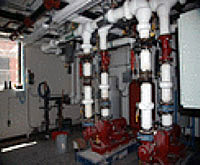
Geothermal heat pump system in the Kiowa County Courthouse building in Greensburg, Kansas
This overview is intended to provide specific details for Federal agencies considering geothermal heat pump technologies as part of a new construction project or major renovation. Further general information is available from the U.S. Department of Energy (DOE) Office of Energy Efficiency and Renewable Energy (EERE) Geothermal Heat Pump Basics.
Description
A geothermal heat pump system is made up of several key components including:
- Ground loop
- Heat pump
- Air delivery system.
The ground loop is a system of pipes that is buried in the shallow ground near the building. A fluid circulates through the ground loop to absorb or relinquish heat within the ground. In the winter, the heat pump removes the heat from the fluid in the pipe, concentrates it, and transfers it to the building. This process is reversed in the summer. The air delivery system uses conventional ductwork or pipe systems to distribute the heated or cooled air throughout the building.
How Does it Work?
Like refrigerators, heat pumps operate on the basic principle that fluid absorbs heat when it evaporates into a gas, and likewise gives off heat when it condenses back into a liquid. A geothermal heat pump system can be used for both heating and cooling. The types of heat pumps that are adaptable to geothermal energy are water-to-air and water-to-water. Heat pumps are available with heating capacities of less than 3 kilowatts (kW) to over 1,500 kW.
Types and Costs of Technology
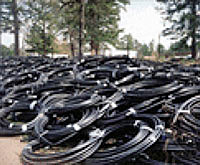
Almost six million feet of 1 in. polyethylene piping was installed with the heat exchangers at Fort Polk.
Geothermal heat pump technologies can be utilized to meet both heating and cooling needs in new construction as well as major renovation projects. Incorporating these technologies into major renovation projects will generally result in higher installation costs than in new construction projects, but can operate at a greater efficiency than typical heating and cooling units. Typical geothermal heat pump systems have a coefficient of performance of 3.5 to 4.0, indicating that for every unit of electricity input to the compression, 3.5 to 4.0 units of heating, or cooling, are produced. A common gas furnace, for example, has an equivalent coefficient of performance of 0.85. Depending on the existing heating and cooling systems in place, incorporating geothermal heat pump systems may not be feasible. Existing buildings with a dedicated boiler and central air handling system are typically most applicable for retrofit scenarios.
At the present time, ground-coupled and groundwater heat pump systems are the two main types of geothermal heat pump systems that are being installed in great numbers in the United States—around 120,000 units per year. Groundwater aquifers and soil temperatures in the range of 40°F to 90°F (5°C to 30°C) are being used in these systems. Just about every state in the United States, especially in the Midwest and eastern states are using these systems; in part, subsidized by public and private utilities. It is estimated that over 1.0 million units (12 kW) are installed throughout the United States. Annual growth rates are around 15%, the fastest of all the direct-use applications.
Ground-Coupled Heat Pump Systems
Also referred to as a closed-loop heat pump, the ground-coupled heat pump system consists of a reversible vapor compression cycle that is coupled with a heat exchanger in the form of bore holes in the ground. These types of systems can use both a water-to-air heat pump or a direct-expansion heat pump.
The water-to-air configuration circulates water or a water and antifreeze solution through a liquid-to-refrigerant heat exchanger and a series of buried thermoplastic piping. In comparison, the direct-expansion heat pump circulates a refrigerant through a series of buried copper pipes. Both vertical and horizontal heat exchanger configurations are used in these applications.
Vertical wells generally consist of two small (3/4 in. to 1 in.) diameter high-density polyethylene tubes in a vertical borehole filled with a solid medium, commonly referred to as grout. Boreholes typically range from 50 to 600 ft, depending on the local site conditions, including soil thermal conductivity and availability of equipment. Because of this configuration, vertical wells require relatively small areas of land compared to horizontal trenches.
Horizontal wells generally require the greatest amount of ground area and can be further divided into three subgroups: single-pipe, multiple-pipe, and spiral-slinky. Single-pipe horizontal ground-coupled heat pumps are typically installed in a single trench to a depth of 4 to 6 ft. and require the most ground area of the three. While the required ground area required for multiple pipes, consisting of two to six pipes placed in a single trench, can be reduced, the total pipe length must be increased to overcome the interference from adjacent pipes. Recommended trench lengths for the spiral pipe configuration can be 20% to 30% of single pipe trench lengths, but may be increased to achieve greater thermal performance.
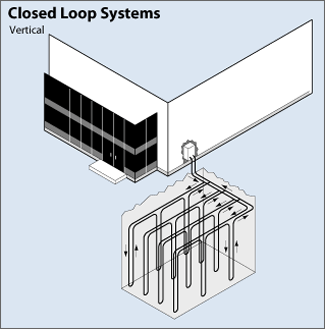
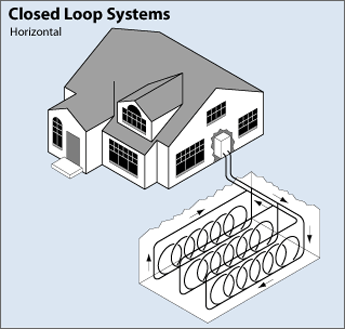
Vertical configuration of a ground-coupled heat pump system
Horizontal configuration of a ground-coupled heat pump system
While the vertical well configuration can yield the most efficient ground-coupled heat pump performance, due to reduced variability in soil temperature and thermal properties along with reduced piping and associated pump energy, costs associated with vertical wells are typically more. The expense of equipment required to drill the boreholes along with the limited availability of skilled contractors also contributes to the higher costs. Because of the reduced installation costs, horizontal trenches are widely used in residential applications. However, these systems generally operate at a reduced efficiency due to the impact of seasonal soil property fluctuations and higher pumping energy requirements. Vertical systems are typically installed in large buildings with limited land area.
Groundwater Heat Pump Systems
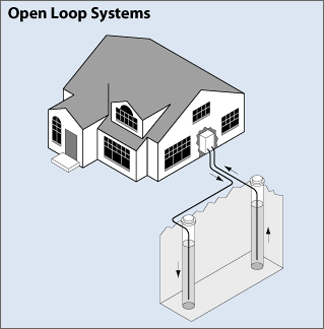
Configuration of a groundwater heat pump system
Preceding the development of ground-coupled heat pump systems, groundwater heat pump systems were the most widely used type of geothermal heat pump system. This type of system uses well or surface body water as the heat exchange fluid that circulates directly through the heat pump system. Once it has circulated through the system, the water returns to the ground through the well, a recharge well, or surface discharge.
A typical groundwater heat pump system design consists of a central water-to-water heat exchanger between the groundwater and a closed water loop that is connected to water-to-air heat pumps located in the building. An alternate strategy is to circulate the ground water through a heat recovery chiller that is isolated with a heat exchanger and used to heat and cool the building through a distributed hydronic loop.
Many sites throughout the United States are well-suited for direct preconditioning using groundwater heat pumps. Ground water temperatures below 60°F can be circulated through hydronic coils in series or in parallel with heat pumps, thereby offsetting energy that would otherwise need to be generated using mechanical refrigeration equipment. Under the right conditions, groundwater heat pump systems can cost less than ground-coupled heat pump systems. This, along with the compact space requirements for the water well and availability of water well contractors, has made this technology popular in large commercial applications and has been used for decades.
Note that potential corrosion issues may require the installation of an intermediate plate-type heat exchanger to protect the heat pump unit. This issue is site-specific and should be evaluated where this technology is being considered. This option is practical only where there is an adequate supply of relatively clean water and all local codes and regulations regarding groundwater discharge are met.
Surface Water Heat Pump Systems
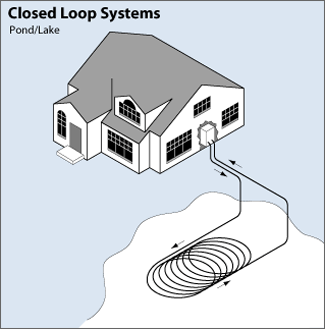
Configuration of a source water heat pump system
While the thermal properties of surface water bodies are quite different than other geothermal heat pump technologies, the applications and strategies are similar. Surface water heat pump systems can be either closed-loop systems, similar to ground-coupled heat pumps or open-loop systems, similar to groundwater heat pumps.
Closed-loop surface water heat pumps consist of water-to-air or water-to-water heat pumps connected to piping loops placed directly in a lake, river, or other open body of water. A pump circulates water or a water and antifreeze solution through the heat pump water-to-refrigerant heat exchanger and the submerged piping loop which transfers heat to or from the body of water.
Open-loop surface water heat pumps can use surface water bodies in a similar way that cooling towers are used, but without the fan energy and required maintenance. Lake water can be pumped directly to water-to-air or water-to-water heat pumps.
Because of reduced excavation costs, closed-loop surface water heat pumps can cost less than typical ground-coupled heat pump systems. While these systems have reduced pumping energy and operating costs along with low maintenance requirements, there is the possibility of coil damage in public lakes and variable performance in small and shallow bodies of water resulting from the wide fluctuation of water temperature.
Application
Geothermal heat pump systems allow for design flexibility and can be installed in both new and retrofit situations. Because the hardware requires less space than that needed by conventional heating, ventilating, and air-conditioning systems, the equipment rooms can be greatly scaled down in size, freeing space for productive use. Geothermal heat pump systems also provide excellent "zone" space conditioning, allowing different parts of the home to be heated or cooled to different temperatures.
For water heating, you can add a desuperheater to a geothermal heat pump system. A desuperheater is an auxiliary heat exchanger that uses superheated gases from the heat pump's compressor to heat water. This hot water then circulates through a pipe to the home's storage water heater tank. In the summer, the desuperheater uses the excess heat that would otherwise be expelled to the ground. Therefore, when the geothermal heat pump runs frequently during the summer, it can provide significant water heating capacity. During the fall, winter, and spring—when the desuperheater isn't producing as much excess heat—the facility will need to rely more on traditional water heating methods. Some manufacturers also offer triple-function geothermal heat pump systems, which provide heating, cooling, and hot water. Of note, when a project is using a geothermal heat pump, it is typically more economical to heat water through the heat pump and solar water heating may not be economic.
Economics
It is common for the geothermal heat pump industry to refer to costs for the ground source portion of the system on a cost-per-ton basis. The table below, focuses on residential-scale systems tracks the actual cost of installed geothermal heat pump systems in a 2008 review of the Indiana Residential Geothermal Heat Pump Rebate program.
| Cost by Geothermal Heat Pump System Type | ||
|---|---|---|
| Tons | Total Systems | Heat Pump Only |
| 2 | $12,285 | $8,400 |
| 2.5 | $13,483 | $7,922 |
| 3 | $13,719 | $9,465 |
| 3.5 | $13,297 | $9,959 |
| 4 | $13,969 | $9,765 |
| 5 | $16,865 | $11,188 |
| Total | $14,278 | $9,990 |
Information from the Indiana Office of Energy and Defense Development.
In addition, according to a 2007 report to Congress on the Ground-Source Heat Pumps at Department of Defense Facilities, operation and maintenance (O&M) costs of geothermal heat pumps at defense facilities was estimated at $7.67 per ton per year. The life-cycle for the heat pump portion of the system is similar to other heat pumps, but the below ground portion is designed to last at least 50 years.
Assessing Resource Availability
Geothermal heat pumps can be implemented anywhere in the United States, because they take advantage of the nearly constant temperature of the shallow ground. They improve humidity control by maintaining about 50% relative indoor humidity, making them very cost effective in humid areas. Resource assessments for geothermal heat pump systems depend on the size of the project.
For small, closed loop projects, such as individual homes or businesses where the size of the installation is approximately less than 6 tons (21 kW), little advanced investigations are normally undertaken. Usually, only the local experience of designers and installers are sought along with any geological or soil information that might be available.
For larger projects, a thermal conductivity test is normally run. This involves installing a loop in a typical bore hole, grouting it, and then hooking the supply and return pipe to a machine that inputs heat into the circulating water and then measures flow and temperature differences. The test is usually run within 36 to 48 hours, and costs around $10,000 to perform. The number of tests for a large project will depend upon the variability of the soil and rock conditions. For open loop systems using well water, the well is pumped to determine flow rate and temperature. Normally, about three gallons per minute is required for each ton (3.5 kW) of load.
Operation and Maintenance
Because geothermal heat pump systems have relatively few moving parts, and because those parts are sheltered inside a building, they are durable and highly reliable. The underground piping often carries warranties of 25 to 50 years, and the heat pumps often last 20 years or more. Since they usually have no outdoor compressors, they are not susceptible to vandalism. The components in the living space are easily accessible, which increases the convenience factor and helps ensure that the upkeep is done on a timely basis.
Special Considerations
Special considerations for geothermal heat pump systems include relevant codes and standards.
Relevant Codes and Standards
Design standards for geothermal direct-use systems typically involve two components:
- Below-ground installation such as drilling wells, casing, and pumps
- Above-ground installations such as pipelines, pumps, valves, heat exchangers, in-building heat convectors, refrigeration equipment, and low temperature components such as heat pumps.
The below-ground equipment standards are usually specified for high temperatures (above 100°C) resources by state and country regulations and standards that would require special values, such as blow-out preventers and drilling muds. These are usually regulated and inspected by departments of geology and mineral industries or local level organizations. Low temperature resources (below 100°C) are usually regulated as standard water wells under the supervision of water resources departments or similar agencies.
Above-ground installation equipment standards are generally not regulated by geothermal requirements, but as standard off-the-shelf equipment. These standards are specified by agencies such as the American Society of Testing and Materials and the American Society of Heating, Refrigerating, and Air-Conditioning Engineers in the United States. Local building codes may also control specifications and installations. The majority of states have not adopted specific codes or standards for most closed loop systems.
Additional Resources
Websites
- DOE's Geothermal Energy Technologies Office researches, develops, and validates innovative and cost-competitive technologies and tools to locate, access, and develop geothermal resources in the United States.
- European Geothermal Energy Council provides information including policy, publications, current project and up-to-date news relevant to the geothermal industry in Europe and elsewhere.
- Geothermal Education Office provides facts about geothermal, view maps of geothermal energy use worldwide and purchase classroom materials.
- Geothermal Heat Pumps offers an overview on the technology from the U.S. Department of Energy.
- Heat Pumping Technologies / International Energy Agency is an organization that supports implementation of heat pumps and related technologies.
- Oregon Renewable Energy Center, Oregon Institute of Technology, aims to enhance development and promote availability of renewable energy through; Energy Systems Engineering, Applied Research, Technical Assistance and Information Dissemination, Academic Degree Programs, and Industrial Training and Development.
- Policymakers' Guidebook for Geothermal Heating and Cooling Technologies from the National Renewable Energy Laboratory provides a five-step process for implementation of geothermal policy and offers resources to increase the use of geothermal heating and cooling technologies.
- Stanford University Geothermal Program provides a general overview of the Stanford Geothermal Program and its research.
Organizations
- Geothermal Rising
- International Geothermal Association
- International Ground Source Heat Pump Association, an affiliate organization with The GeoExchange Organization
Training
- International Ground Source Heat Pump Association Training Courses and Resources
- National Geothermal Academy, Great Basin Center for Geothermal Energy









